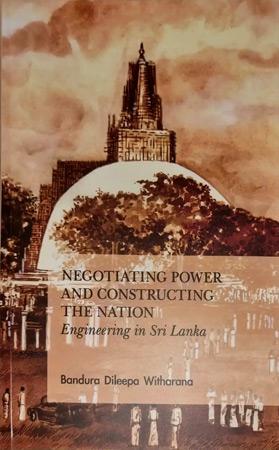
Book: Negotiating Power and
Constructing the Nation:
Engineering in Sri Lanka
Writer: Bandura Dileepa Witharana
Publisher: Tambapanni Academic Publishers, 2022
This book is about the relationship between engineering and nationalism in Sri Lanka. It takes us beyond the most widespread claim on nationalism as a cultural phenomenon to show the complex relationship between Sri Lankan engineering and Sinhala nationalism.
Witharana takes a new approach towards engineering as a science on materiality as well as a text and a discourse.
It is applied to three very different technological sites namely - Aberdeen-Laxapana Hydro Electric Scheme (1900-1936), the Accelerated Mahaweli Development Project (1978-1985) and Discourse on Ravana, the engineer and the mythical king of the epic Ramayanaya and his technological dynasty (2000-2016) - by situating them in relevant socio-political contexts and times. By doing so, the author shows that Sinhala nationalism is closely enmeshed with engineering in distinct ways. This book argues that engineering is not simply an object, an artefact or a program, but also a condition, a myth, a symbol, a tool, an actor, a worksite, a conceptual space and a community (p.163).
Witharana’s sources vary from sessional papers and administrative reports of the British period to memoirs, reports of public events and processes, biographies to oral histories collected through in-depth interviews which provides rich evidence of discourses and practices of engineering in Sri Lanka.
Chapters
Apart from the Introduction and the conclusion, this book contains four chapters. The second chapter details the prevailing popular narrative of Sri Lanka’s engineering through three cases from academic, professional and public spheres. Third, fourth and fifth chapters analyse the engineering-nationalism nexus in the three technological sites.
‘Technology tends to enable members of a nation, as an imagined community, to either look forward and visualise a common future or to look backward and remind themselves of a shared past.
The AMDP case shows how a modern engineering site was used as a means to remobilise Sinhala nationalism by reviving memories of a glorious past’ (p. 162).
Aberdeen-Laxapana Hydro Electric Scheme showed the possibility of a Ceylonese developmental nationalism while Ravana’s technological dynasty presents an imagination of a Sinhala national past that goes even deeper than Accelerated Mahaweli Development Project.
Trajectories of nationalism
Our lives have taken a dynamic turn recently with the essential use of technology – most specifically online technology - due to the Covid 19 Pandemic.
However, we do not associate engineering of technology with nationalism. I think the most significant contribution of this work is that Witharana invites us to see multiple trajectories of nationalism that engineering could bring in by performing specific acts of engineering to serve the interests of the nation and mobilising a particular Sinhala imagination of the nation through material, conceptual and symbolic heritage.
This helps us problematise the unilinear narrative of Sinhala nationalism that we are familiar with. He also cautions us in understanding engineering marvels of ancient Ceylon as cultural heritage that leads us towards a particular form of ethno-nationalism.
Thus, this work pushes the boundaries of history writing by connecting engineering with Sinhala nationalism and at the same time acts as a profound piece of work that creates a particular political consciousness.
The writer is attached to the Department of History, University of Colombo.
